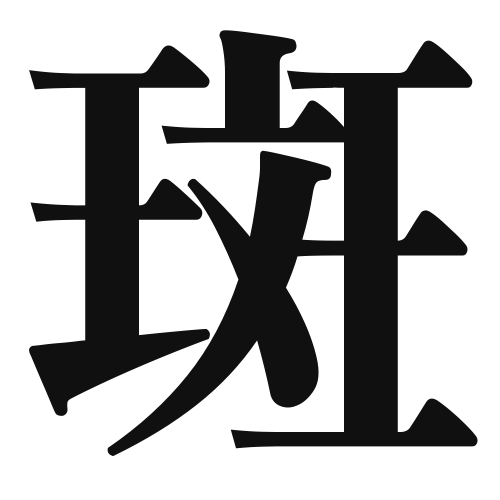1. Overview of Meaning
The kanji “斑” (han) generally means “spot,” “streak,” or “mottled.” It describes something that has irregular patches or colors, often used to refer to patterns found in nature, such as the markings on animals or the appearance of certain minerals.
2. Formation and Radical
Formation of the Kanji: The kanji “斑” is a compound character (会意文字) that combines elements to convey its meaning. The left part “斑” suggests a pattern or mark, while the right part can be associated with the concept of “to divide” or “to separate,” emphasizing the irregularity of the spots.
Radical: The radical for “斑” is “斑” itself, which relates to markings or patterns.
3. Examples of Usage
Common Words and Phrases:
- 斑点 (はんてん, hanten) – “spot” or “dot”
- 斑馬 (はんば, hanba) – “zebra”
Example Sentences in Daily Conversation:
- この石には美しい斑点があります。 (このいしにはうつくしいはんてんがあります。) – “This stone has beautiful spots.”
- 斑馬は白と黒のストライプがあります。 (はんばはしろとくろのすとらいぷがあります。) – “Zebras have black and white stripes.”
4. Synonyms and Antonyms
Similar Kanji:
- 点 (てん, ten) – “dot” or “point,” which refers to a small mark or spot but does not imply the irregularity that “斑” does.
- 模様 (もよう, moyou) – “pattern,” which can refer to any design but is broader than the specific meaning of “斑.”
Antonyms:
- 均一 (きんいつ, kin’itsu) – “uniform” or “even,” which describes something that is consistent and lacks irregularity.
5. Cultural and Historical Background
Relation to Japanese Culture: The concept of “斑” is often found in traditional Japanese art and nature, where irregular patterns are celebrated for their beauty and uniqueness. This reflects the Japanese aesthetic of appreciating the imperfections in nature.
Proverbs and Idioms:
- 「斑があるからこそ美しい」 (はんがあるからこそびしい) – “It is beautiful because it has spots,” which emphasizes the idea that imperfections can enhance beauty.
